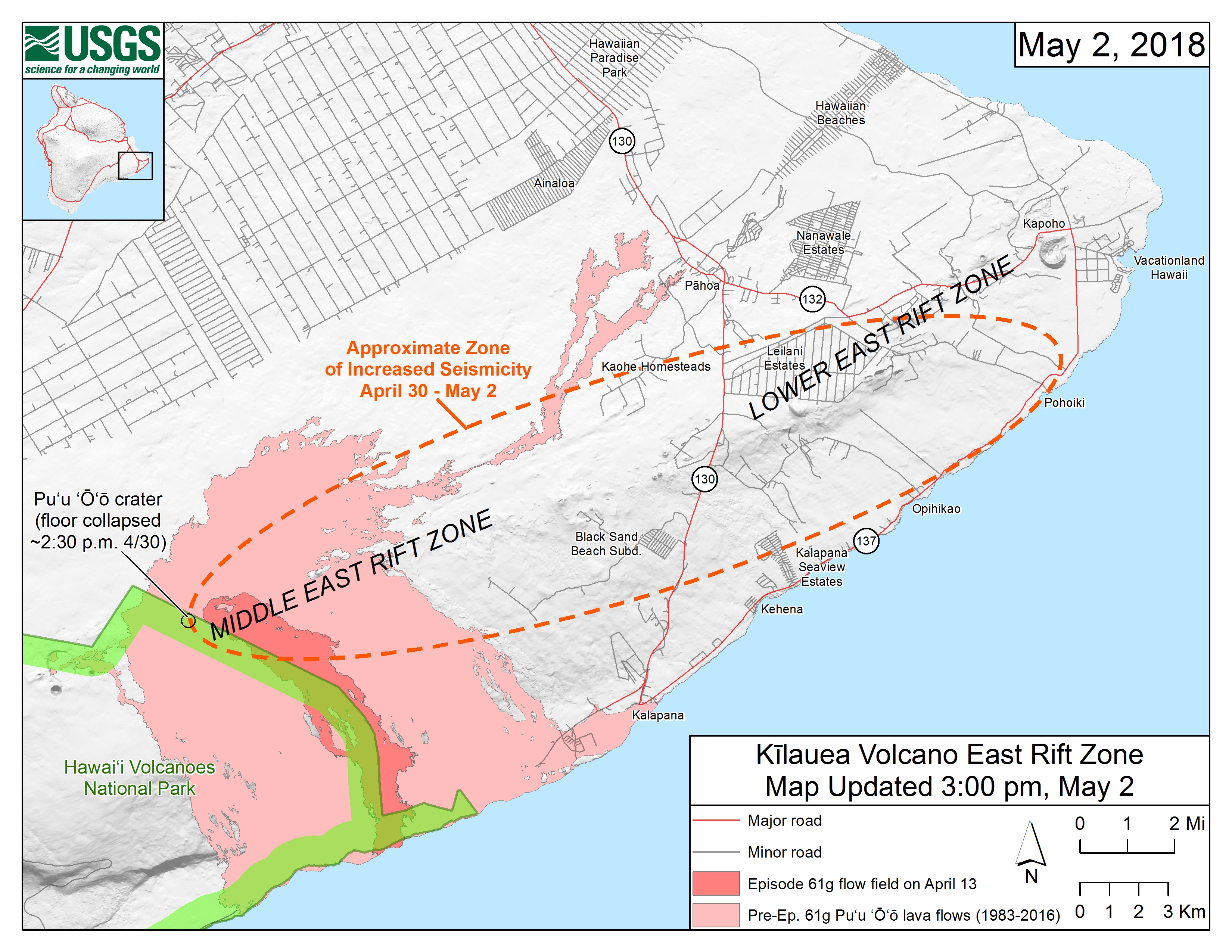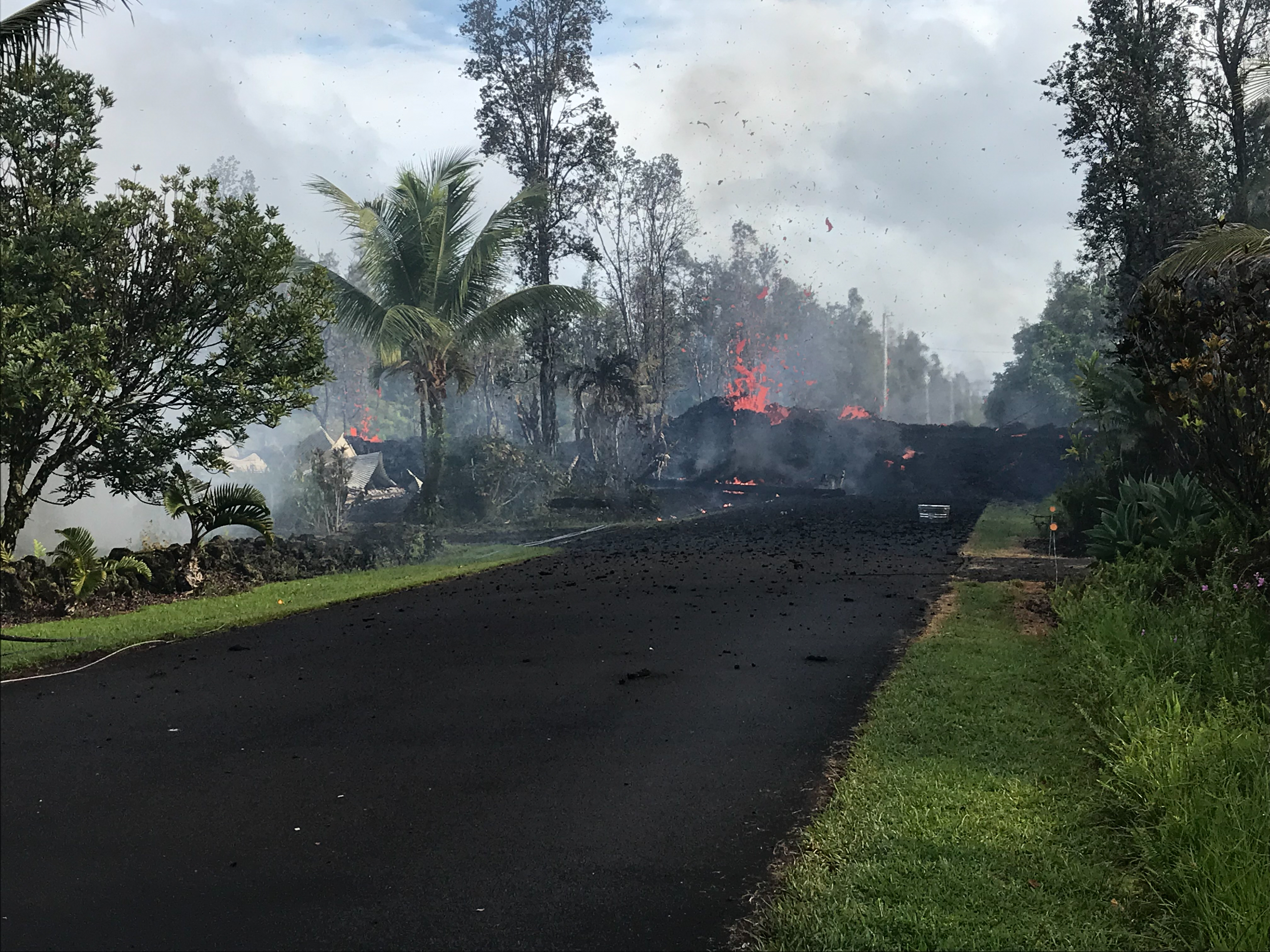HVO Scientist-in-Charge Tina Neal gave an EXCELLENT evening briefing on the first 24 hours of the Leilani Estates Eruption, explaining very clearly what was happening and why.
[Big Island Video News, overlaid with video from Mick Kalber flyover]
Powerpoint slide summary of TALK:
- 6 fissures in first 24 hours — more are expected
- No lava flows extending more than tens of yards so far — flows are expected
- Magma intrusion into LERZ [Lower East Rift Zone] is continuing
- High levels of sulfur dioxide gas [SO2] near fissures and downwind
- More Magnitude 5+ earthquakes possible as volcano adjusts to intrusion
Excerpts from this Briefing:
“The eruptions from each of these fissure vents might last longer than what we’ve seen to date. Currently these fissures have opened, been active for maybe a few hours or more, and then they’ve been shutting off. So it’s highly likely that further ones will activate, emitting lava for longer periods of time.”
“The activity has been low enough level— which is not to diminish the impact— but it’s not producing extensive lava flows yet. And that’s just because there’s not enough molten material coming out of the ground. But in the future, if that eruption rate increases, then we would expect lava flows to be produced that move further away from the vents in a downslope direction.”
“The arrival of new magma into this portion of the rift zone, which we call the Lower East Rift Zone, is continuing. That’s what I mean by ‘magma intrusion is continuing.’ […] We know that from two lines of evidence. We’re still seeing earthquakes in the region, and you’re probably still feeling some— today was an exceptional day for that. Also we have some instruments that are measuring the motion of the ground, and the ground is still moving in directions that are consistent with more molten material coming into that reservoir.”
“There are very high levels of sulfur dioxide and other volcanic gasses coming out of these fissures. And that’s to be expected, because these gasses are dissolved in the magma, and when the magma reaches the surface, just like the bubbles in your champagne, they come out and blow downwind.”
“Today we had a series of strong shocks, and it’s very likely that we’ll see more in the coming days and weeks, as the volcano adjusts to this intrusion or motion of magma underground.”
[Map shown in slideshow presentation]

“This map shows in the dotted line the region where we’ve been seeing the elevated earthquake activity for some time now, since April 30. If you followed these earthquakes on our website, you saw that they marched slowly to the northeast. And that slow progression was reflecting the slow motion of magma in the rift zone underground as it moved to the northeast.”
“What you’ll notice is that the zone starts on the lefthand side right at the Pu’u O’o vent. And what you may remember on Monday is there was a large collapse at the Pu’u O’o vent. The crater which had been uplifting and swelling for many weeks fell in, and created a deep void, and all of the molten material that had been stored below Pu’u O’o basically drained into the rift zone and down the rift zone towards this portion of the rift zone. And as it did so, it was making earthquakes, deforming the ground. Now we have no more lava visible at Pu’u O’o, because it’s all coming downrift.”
[Talks about locations of six fissures so far; only last one was active at time of talk.]
“These fissure vents are opening in a predictable, or, I should say, a repeatable sequence of events. Some of you may have witnessed this. First we are getting these ground cracks that can widen over the course of hours, and then we start to get steam, hot steam coming out of the cracks, and then we start to smell — or detect sulfur dioxide volcanic gas, as the magma gets even closer, and then eventually it breaks through the surface.”
[Here’s a USGS video of this sequence of events at Fissure 3, 6AM May 4. I assume the beeping is from volcanic gas detectors.]
[Shows map of earthquake activity in area, explains locations on map.]
“These are the locations of the largest earthquakes that we’ve been detecting and feeling in the last three days. Here’s the 6.9 that happened just early this afternoon. I’m sure many of you felt that. It was just three miles deep, below the south coast of the island.
“All of these earthquakes today represent the response of the volcano to this ongoing intrusion of magma in the East Rift Zone. Basically, you can imagine that the movement of great volumes of molten material through that passageway that’s several miles deep is stressing the volcano. It’s pushing on the sides. It’s also perhaps providing room for the volcano to collapse a little bit, and all that stress is relieved in large earthquakes.
“So in some ways these are not unexpected. The size of today’s event is a little dramatic. Because of the large earthquakes, we expect to have aftershocks continuing for several days, and perhaps even weeks.”

“Here’s a photograph of what happens at the tail end of one of the crack development events. First crack, steam and fumes, and then lava spattering through the fissure vent, and the spatter falls on either side and builds up a spatter rampart with a little cone of debris. This isn’t very vigorous activity; these lava fountains aren’t going very high. But the impact is severe nonetheless.”
[BigIslandVideo added excerpt of USGS night video of Fissure 2 on Friday May 4, 1AM.]
“So to recap… we’ve had six separate little fissures form in a short area over the course of this eruption to date [evening of May 4, one day after lava started erupting]. We expect more, and it’s possible, if not likely, that effusion, or eruption of lava from these may become longer in duration, produce more volume and actual lava flows that move downhill away from the fissure vents.”
“We’ve talked about the gas hazard, and that is real. When I did the overflight today, you could see this incredible plume coming out of the fissure vents, and we don’t want to be in that cloud if we can avoid it. And again, we are likely to feel more earthquakes as the event progresses.”